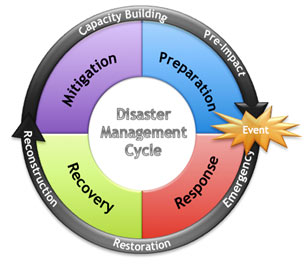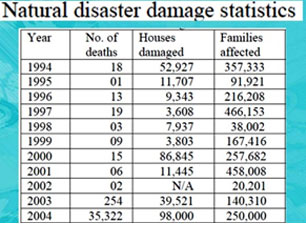|
A Natural Disaster is a major adverse event resulting from natural processes of the Earth; examples include floods, hurricanes, tornadoes, volcanic eruptions, earthquakes, tsunamis, and other geologic processes. (Anon., n.d.)
Disaster Management can be defined as the organization and management of resources and responsibilities for dealing with all humanitarian aspects of emergencies, in particular preparedness, response and recovery in order to lessen the impact of disasters. (cross, 2010-2011).
|

Figure -01 Disaster Management Cycle
|
In the aftermath of natural disasters, often the initial reaction of the general public is to cast blame on the parties who failed to build and design sufficient structures that would have prevented the extensive damage. The public often questions the responsibility of the engineers and whether or not the engineers fulfilled their duties.
As the victims of natural disasters, blame and responsibility become a secondary concern. Obtaining the basic necessities, such as food, clean water, and shelter, takes the highest priority. Survival becomes the primary concern.Civil engineers must hold paramount the safety, health, and welfare of the public, as stated in the First fundamental Canon of the ASCE Code of Ethics (Chang, March 1, 2014).
|
| |
|
According to the statistics of natural disasters in Sri Lanka, the number of deaths, house damages and families affected shown above. Year 1994, 2000 and 2004 was the highest number of houses damaged.
Consequently, civil engineers have three major responsibilities following a natural disaster. Immediately after a natural disaster, civil engineers are responsible for providing the basic necessities for survivors. Once these basic needs of the survivors are met, civil engineers then have the responsibility to restore the public’s confidence in the engineering profession. The final duty of civil engineers is to prevent the catastrophic effects due to natural disasters from repeating in the future.
|

Figure 02 – Natural disaster damage statistics
|
|

Figure 03 -Natural Disasters occurs in Sri Lanka from 1980 to 2010
|
|
As figure 03, between the year 1980 to 2010 the main disaster faced in Sri Lanka was Flood and the number reported as 45. Once civil engineers have met the survivors’ basic needs, civil engineers are then responsible for restoring the public’s confidence in the engineering profession.
After the civil engineers have restored public confidence in the industry, the final responsibility of the civil engineer after a natural disaster is to prevent the catastrophic results from repeating in natural disasters in the future.
Civil engineers have three main responsibilities following the events of natural disasters such as Tsunami in Sri Lanka 2004, Hurricane Katrina in USA and the 2011 Tohoku Earthquake. Immediately after the natural disaster, the civil engineer must meet the basic needs of the victims by providing food, clean water, and shelter.
Once the situation of survivors has stabilized, civil engineers are responsible for reestablishing public confidence in the civil engineering profession. Lastly, civil engineers have the duty to prevent the catastrophic effects of natural disasters from repeating in the future. Often as civil engineers, we find ourselves behind a desk immersed in calculations of skyscrapers or water-treatment plants. We have the tendency of becoming lost in the technicality of engineering and removed from the people for who we design. Ultimately, the most important duty and responsibility of civil engineers is never forgetting the people we serve.
REFERENCES
- Anon., 2017. Disaster management, s.l.: World confederation for physical therapy.
- Anon., n.d. Natural disaster. p. https://en.wikipedia.org/wiki/Natural_disaster.
- Chang, J., March 1, 2014. “Duty and Responsibility of Civil Engineers Following Natural Disasters”, Carnegie Mellon: Department of Civil and Environmental Engineering.
- cross, i. f. o. r., 2010-2011. About disaster management.
- WHO, 2014. National Training on Safe Hospitals - Sri Lanka. s.l., WHO, pp. Module 2 Session 1 -.
|
| |
|
|